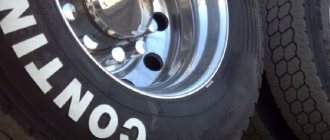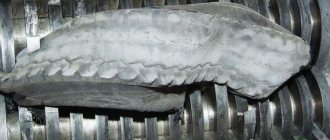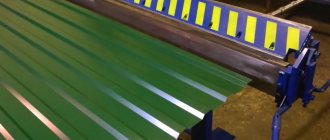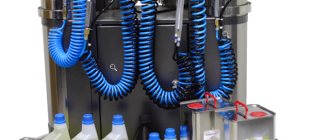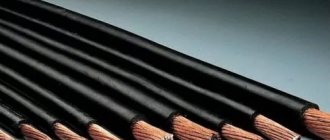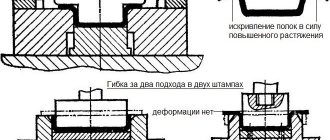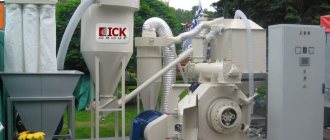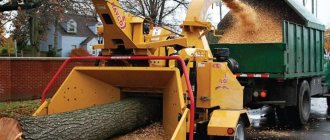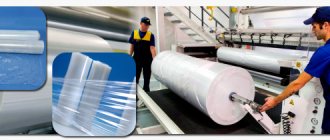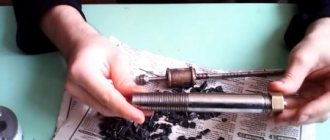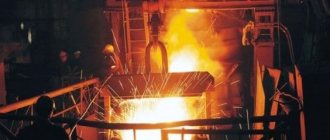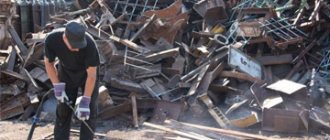Today's market is literally replete with various industrial installations for small and large businesses. Among this diversity, even experienced specialists sometimes literally run wild. In this article we will look at equipment for the production of sawdust and its derivatives (pellets, granules).
After all, getting raw materials for this business in our country is not a problem; you can negotiate with any forestry department about the collection and removal of dead wood and dead wood. This way you will clear the forest and earn money from it.
Problem of choice
Before purchasing an industrial unit, most buyers naturally have questions: “Which type is better to choose?” “Should I buy new or used equipment?” “Cheap or expensive?” Let's take a brief look at the three main options.
1. New turnkey installation.
2. Used line.
3. Buy parts from different manufacturers and assemble them yourself on site.
Each of these options has its pros and cons, but before considering them, you should familiarize yourself with the theoretical part.
Equipment for making pellets
This installation has several configuration options.
1. Line for processing wood or lump waste (includes equipment for sawdust production).
2. Line operating on industrial wood waste (no additional grinding machine is needed).
3. Pelleting line for raw materials with a moisture content of more than 13% (an additional drying complex is required).
4. Line working with material whose humidity is less than 13%.
A complete list of equipment for such an installation: a hammer mill, a disk and drum crusher, a gas (or wood-burning) boiler, a drying drum, as well as a mechanism for loading chips into it, a cyclone, a smoke exhauster, a belt or scraper conveyor, movable floors, a fan, a mixer, a hopper for raw materials with a conveyor, a granulator press, a cooler, a sieve, a fan for removing dust and screenings, a hopper for finished pellets, scales, a packaging machine.
What should you consider when purchasing equipment for the production of sawdust and their derivatives? Let's look at the pros and cons of the three options.
Equipment for the production of sawdust briquettes
According to the technology for producing briquettes from sawdust, this technological process should include the following steps:
- Grinding raw materials into a fine homogeneous mass;
- Drying. The raw materials are dried until the moisture content reaches the permissible value of 12-13%;
- Pressing into briquettes. The dried raw materials are pressed into briquettes under pressure and high temperature;
- Slicing and packaging. Finished briquettes are cut and packaged depending on the conditions set by the customer for the finished product: size, shape and dimensions.
Accordingly, the equipment used for the production of fuel briquettes from sawdust at each stage must meet the requirements of the technology of this type of production:
- To grind production raw materials in the production of fuel briquettes, special crushers, mills and chipping machines are used, depending on the type of raw material and the characteristics of production;
- Drying occurs using special dryers that include a heat generator. In addition to drying drums, aerodynamic, dynamic and pneumatic dryers are also excellent for these purposes;
- Pressing into briquettes occurs through the use of presses of various types, such as: impact-mechanical press, extruder, hydraulic. The type of press used affects, among other things, the shape of future fuel briquettes. They can be rectangular, cylindrical, square, and also have different sizes. In this case, everything depends on the wishes of the customer and the purposes of his use of future fuel briquettes;
- Briquettes of various sizes are cut using special cutting machines. The briquettes are fed onto a special belt, where they are cut automatically, according to the dimensions of the finished fuel briquettes programmed into the device. For ease of transportation (especially when purchased on a large industrial scale), briquettes can be packaged on another conveyor belt.
Republished by Blog Post Promoter
Turnkey line
The advantages of this option include:
- Minimum number of labor hours spent on installation and high quality of such work.
- Eliminating the purchase of a “pig in a poke” - high-quality new equipment will function better and longer without breakdowns.
- In addition, modern technology is characterized by a longer service life, it is less energy-intensive, which will reduce the cost of manufacturing the final product.
Disadvantages include:
- The high cost of such a project.
- Lack of self-service capability, which will consequently lead to equipment downtime even with minor breakdowns. This happens because the installation is under warranty and service. As a result, even if a hose breaks, replacing which takes about 20 minutes, you still need to call the company’s specialists, and this may take several days.
Enterprise registration
A business plan includes calculations of investments, potential profits and possible risks. The cost of official registration must be included in the expense item. Depending on the volume of business and its focus, the organizational and legal form of entrepreneurial activity is selected: individual entrepreneur or LLC.
If you plan to scale, it is better to open a limited liability company and choose a simplified taxation regime according to the scheme: “income minus expenses.” You will have to spend 10,000 rubles on this.
No licensing is required for a recycling business. But product certification is needed. The price of the procedure depends on the type of products manufactured. To certify the production of pellets you will need 30,000 rubles.
Used line
The advantage of this option is its low cost. If you monitor the domestic and import markets for used equipment, then it is quite possible to pick up a used unit in good condition at a low cost. In addition, you can find an option with much higher performance than the new line for the same money.
The disadvantages are: buying a “pig in a poke”, complex installation with the introduction of your own innovations, not always complete equipment, insufficient documentation. In addition, warranty and service maintenance are excluded, and the likelihood of using original spare parts is reduced. If the installation is very old, then spare parts for it are no longer manufactured.
When purchasing new equipment, you should adhere to the following recommendations: conduct a thorough inspection and listen to the operation of the line for the absence of extraneous noise, special attention should be paid to the head part (drying complex, crusher, press). In addition, opt for efficient lines from more recent years.
Complete line
This is a rather rare option, but it also has a right to exist. In fact, this is the cheapest scheme, but at the same time the most complex. It is more suitable for those who have extensive experience in this business. Often, with this purchase option, you can also get one or another unit for practically nothing.
If you decide to install a complete line, then it is better to purchase new components for the most important components, and used ones for secondary ones. In this case, you will be able to save significant money, but you will have to tinker with the installation of equipment.
Various options for sawdust implementation
To summarize, it can be noted that this business will be very profitable if you do not become fixated on only one area of selling your product. After all, it is used everywhere - from fertilizers to construction, which means there will definitely be a demand for it.
For example, you can start producing sawdust for smoking and fuel briquettes (today such a product is in high demand, because briquettes burn four times longer and produce more heat than firewood). For this, it is better to use fruit tree species as raw materials. At the same time, start producing sawdust for animals, because bedding is needed not only for pets, but also for cattle, for this, establish contacts with farmers.
To make cat litter, you will need to use a granulator. As raw materials, in addition to sawdust, you will need sorption components: cellulose, chalk, carbomethylcellulose glue, in addition, zeolite should be added to absorb unpleasant odors.
To produce bedding, any tree species, corn cobs, etc. can be used as raw materials. Be sure to start making sawdust-based insulation, because the construction industry today is more relevant than ever. If you occupy several areas at once, then profit for your enterprise will be ensured.
What can be made from sawdust - business ideas
Recycling sawdust, wood chips and other wood waste is a way to organize profitable production and one of the options for protecting the environment. Wood waste processing products are a sought-after material in thermal power engineering, construction, and crop production. They are used to make acetic acid, turpentine, industrial alcohol, and biofuel. Sawdust is a natural material that is considered a high-quality insulation material and is used for thermal insulation of pipes (thermolite, sawdust concrete).
Recycling wood waste can be a great idea for organizing and developing a business.
The sawdust processing process is not too complicated; pressing and briquetting technologies are available even for small businesses.
The most important thing in planning future production is to determine the type of products that can be produced and profitably sold on the regional market.
Production of pellets and briquettes
Wood processing waste is an excellent raw material for the production of fuel pellets, which have high heat transfer and emit a minimal amount of carbon dioxide during combustion:
- pellets are easy to transport;
- unlike firewood, they have a low level of fire hazard;
- they are completely environmentally friendly.
For production you will need a crushing chamber, mixer, dryer and granulator. Such a production line can produce up to 1 ton of product per hour.
Sawdust is the basis of another type of environmentally friendly fuel - braces, which are ideal for lighting stoves, fireplaces, grills, barbecues and barbecues. Briquettes do not produce sparks when burned, have high heat transfer and minimal smoke emission.
Furniture made from wood products
MDF, laminated chipboard and fiberboard are an environmentally friendly and inexpensive semi-finished product from crushed wood waste, which is used for the manufacture of cabinet furniture in the middle price category . Particle boards are the basis for the production of cabinets and countertops.
Unlike capricious and expensive products made from solid wood, such furniture can be used in conditions of different levels of humidity and temperatures, and is easily assembled without taking into account deformations during drying and the direction of the fibers.
Sawdust building blocks
Panels and blocks made of wood concrete (wood concrete) are a popular material in low-rise construction. It is based on lightweight concrete, wood shavings and chemical additives that serve to neutralize the negative effects of organic matter on the hardening of cement. The material is attractive for its environmental friendliness, high heat and noise insulating qualities, resistance to biocontamination, and fire safety.
Wood concrete is an excellent alternative to expensive and heavy bricks; it is used in the construction of internal walls or partitions, and also serves for additional insulation and sound insulation of the room.
Wood flour for fertilizer
Sawdust fertilizers are in good demand among gardeners: they are used for fertilizing and mulching beds. To obtain wood flour, sawdust is crushed and mixed with mineral components, forming a complex fertilizer. For production you will need a drying chamber, a crusher and mixers with dispensers.
Production of Eco insulation materials
Both frame houses and communication lines are insulated with thermolit. For its production, sawdust is used, which does not require pre-drying. Thermal insulation is obtained by mixing crushed wood waste with a binder (cement, glue) and gypsum or lime.
Kit for mycelium in bags
The basis of the substrate for growing mushrooms is wood shavings. To implement the idea you will need plastic film, twine and a backing.
The difficulty lies in the specialization of the production of such products - different types of mushrooms require different substrate mixtures.
For champignons, an addition to the sawdust of regular compost is enough. Oyster mushrooms do not require any additives at all and grow well on wood shavings. Exotic mushrooms such as shiitake mushrooms require wood shavings with cellulose-containing substrates for mycelial growth.
Making filler for gift boxes
Colored shavings and fibers are widely used as a sealant and decorative element in the design of gift boxes. Their presence not only emphasizes the aesthetic qualities of the gift, but also helps protect it from mechanical damage during transportation. Colored wood chips are used by landscape designers to mulch and effectively design beds with plants.
Making wood pellets for pet litter
The use of a dryer and granulator will make it possible to produce one of the most popular products from sawdust - cat litter. There are more than 30 million domestic cats in Russia, most of them live in city apartments and need hygiene products. The products can be sold in pet stores and supermarkets. You can also set up wholesale sales.
